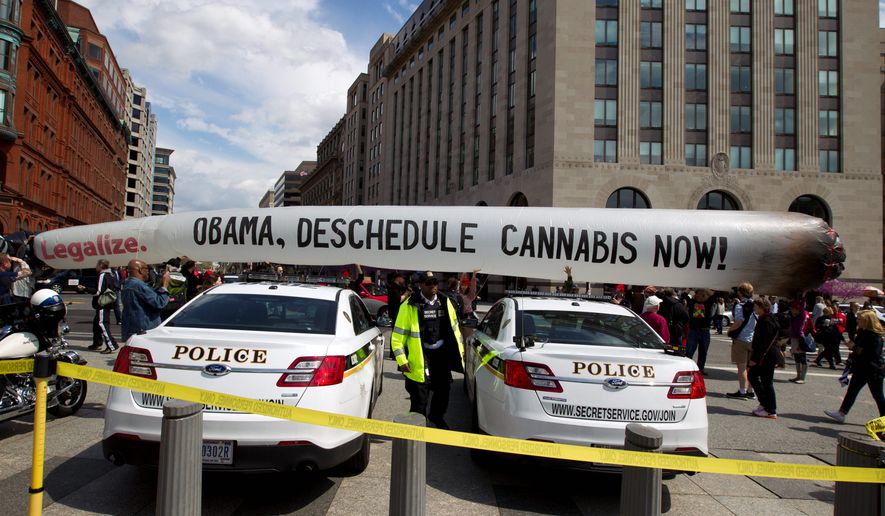The local activists who helped legalize marijuana possession in the District were on the trail of bigger game Saturday, lighting up in front of the White House to protest the way federal laws classify the drug.
“This is about needless incarceration,” Dave Anderson said as he walked along a 51-foot inflatable joint that protesters planned to march from 15th Street NW and Pennsylvania Avenue NW to the gates outside of the north lawn of the White House. “We’ve got local momentum in D.C., so this is an opportunity for a dialogue.”
D.C. voters approved the legalization of marijuana in November 2014, and the law became effective in February 2015. It allows residents to possess and grow small amounts of pot, but it bans the sale, distribution and public consumption of the weed. The law does not apply to federally owned land, including federal parks.
The legalization ballot measure, which was approved by 70 percent of voters, was spearheaded by DCMJ, a local organization formed in 2013 to advocate for cannabis users in the District.
And on Saturday, that same group rallied a couple of hundred activists to break the law and consume marijuana on the federally-owned land in front of the White House as a way to get their message out nationally.
Currently, marijuana is classified as a Schedule 1 drug, which the Drug Enforcement Administration defines as “drugs with no currently accepted medical use and a high potential for abuse.” Heroin, LSD and Ecstasy are also classified as Schedule 1 drugs.
SEE ALSO: Muriel Bowser, D.C. mayor, bans official travel to North Carolina to protest bathroom law
But DCMJ thinks marijuana has to be either reclassified or simply taken off the list of most dangerous prohibited drugs.
“While we have been able to drastically reduce arrests for marijuana possession in the District of Columbia, millions of Americans across the United States are not so lucky,” the group wrote on its website. “As long as cannabis is treated in the same category of drugs as heroin, with no accepted medical use, police will continue to arrest and lock up our brothers and sisters.”
The civil disobedience was widely publicized on social media and brought in dozens of protesters from across the country, many with highly personal stories of their experience with pot.
Ricardo Rivera drove down from New Jersey to raise awareness for children with illnesses who can benefit from monitored cannabis use. Mr. Rivera’s daughter suffers from Lennox-Gastaut Syndrome, a rare and serious form of epilepsy, and said cannabis has decreased her seizures by 95 percent.
“We could get her seizure-free if I had easier access to it,” he said.
For now, Mr. Rivera must get the cannabis himself, break it down and turn it into an oil to treat his daughter.
SEE ALSO: D.C. child population grows, shifts to neighborhoods of young professionals
Mr. Rivera isn’t alone in calling for legalized marijuana treatments. The Epilepsy Foundation of America, a national nonprofit advocating on behalf of epilepsy patients, has also come out in favor of access to cannabis for seizure sufferers.
And the American Academy of Pediatrics last week formally endorsed reclassifying marijuana so it could be more easily researched for medical use.
For protester Valencia Mohammed, the issue is those sent to jail for small amounts of marijuana.
“He came back angry,” Ms. Mohammed said of her son Imtiaz Mohammed, who was sent to Oak Hill Youth Center for six months for possessing a small amount of the drug back in the 90s when he was a teenager. “The judge made it seem like he was in the Medellin cartel.”
Ms. Mohammed said that time would have been better spent in her care rather than in jail, which she said irrevocably toughened him. In 2005, Imtiaz Mohammed was gunned down in D.C.’s Brightwood neighborhood in Northwest.
And for other, legal marijuana is simply the most effective way to help them relax.
“It’s a stress and pain relief,” Sean Hyson, a Capitol Hill resident said at the protest. “I come home, smoke a joint and I’m great.”
“Compared to alcohol and tobacco, well, they’re known to kill a lot more people than marijuana,” he said.
There was no noticeable counterprotest Saturday, and several of the tourists rubbernecking as they made their way to monuments and restaurants voiced their support for the group’s cause.
“It’s long overdue,” said Mike Martin, who traveled from Illinois to visit the District but was not part of the protest. “There are too many people in prison for it.”
Mr. Martin said he doesn’t smoke marijuana, but doesn’t see a reason why people should be punished for it.
And while protesters who decided to smoke were ready to be arrested, Secret Service police, who patrol the areas outside the White House, remained calm. No one was arrested and only a few $25 public consumption citations were handed out by District police.
• Ryan M. McDermott can be reached at rmcdermott@washingtontimes.com.




Please read our comment policy before commenting.